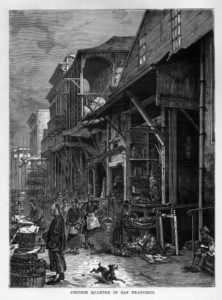The Asian American Legal Foundation owes its existence to generations of Asian Americans, particularly in California’s century-and-a-half old Chinese-American community, who struggled to obtain the equal protection of the laws promised to all persons by the Fourteenth Amendment to the United States Constitution. Throughout their history in this country, individuals of Chinese descent sought to participate in and contribute to American society but often faced significant barriers solely because of their race. See, e.g., Charles McClain, In Search of Equality (Univ. of Cal. Press 1994); Elmer Clarence Sandmeyer, The Anti-Chinese Movement in California (Univ. of Ill. Press 1991); Victor Low, The Unimpressible Race (East/West Publishing Co. 1982).
Time and again, Chinese Americans received equal treatment only after appealing to the federal courts for the protections guaranteed individuals by the United States Constitution.The long battle over basic rights, jobs, schools and other opportunities produced many of the pivotal court decisions that eventually gave rise to modern equal protection jurisprudence.
- In the Supreme Court case of United States v. Wong Kim Ark, 169 U.S. 649 (1898), a Chinese American, born in San Francisco, had to petition the courts for the right to be allowed to return to America after a trip overseas.
- In Yick Wo v. Hopkins, 118 U.S. 356 (1886), the Supreme Court declared that Chinese-Americans were “persons” under the Fourteenth Amendment’s equal protection clause, and could not be singled out for unequal burden by San Francisco’s anti-Chinese laundry licensing laws.
- In In re Lee Sing, 43 F. 359 (C.C.D. Cal. 1890), Asian Americans successfully petitioned the Court to declare San Francisco’s “Bingham Ordinance,” mandating residential segregation, unconstitutional).
- In In re Ah Chong, 2 F. 733 (C.C.D. Cal. 1880), the Court found that a law forbidding Chinese-Americans from fishing in California waters was unconstitutional. In re Tiburcio Parrott, 1 F. 481 (C.C.D. Cal. 1880), Chinese-Americans successfully challenged a provision of California’s 1879 Constitution that forbid corporations and municipalities from hiring “Chinese.”
- In Ho Ah Kow v. Nunan, 12 F. Cas. 252 (C.C.D. Cal. 1879), San Francisco’s infamous “Queue Ordinance” was invalidated on equal protection grounds.
- The struggle has often been over access to public schools. In Tape v. Hurley, 66 Cal. 473, 6 P. 12 (1885), San Francisco’s public school system was ordered to admit a girl of Chinese descent. In response, the California legislature authorized separate “Chinese” schools to which Chinese American schoolchildren were restricted by law until well into the twentieth century. See Ho, 147 F.3d at 864. Chinese American schoolchildren were some of the earliest victims of “separate but equal” jurisprudence as it related to education.
- In Wong Him v. Callahan, 119 F. 381 (C.C.N.D. Cal. 1902), the district court denied a child of Chinese descent the right to attend his neighborhood school in San Francisco, reasoning that the “Chinese” school in Chinatown was “separate but equal.” 119 F. at 382.
- In Gong Lum v. Rice, 275 U.S. 78 (1927), the Supreme Court affirmed that the separate-but-equal doctrine articulated in Plessy v. Ferguson, 163 U.S. 537 (1896), applied to schools, finding that a nine-year-old Chinese American girl could be denied entry to a “white” school because she was a member of the “yellow” race. at 87.
The role of Asian Americans in shaping civil rights jurisprudence has not gone unnoticed. In Lee v. Johnson, 404 U.S. 1215 (1971), Supreme Court Justice Douglas wrote that California’s “establishment of separate schools for children of Chinese ancestry . . . was the classic case of de jure segregation involved [and struck down] in Brown v. Board of Education, 347 U.S. 483 [1954]. . . .” Id. at 1216. As Justice Douglas declared, “Brown v. Board of Education was not written for blacks alone. It rests on the Equal Protection Clause of the Fourteenth Amendment, one of the first beneficiaries of which were the Chinese people of San Francisco.” 404 U.S. at 1216.
It is a proud legacy. And the lessons learned are still relevant today. In case after case, the single historical truth that emerges is that the rights of people of Asian American descent—and of all Americans—have been vindicated only by strict application of the Fourteenth Amendment’s protection of individual rights.
The Asian American Legal Foundation is dedicated to the mission of carrying the torch forward.
